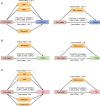Associations Among Sleep Duration, Sleep Quality, and Age-Related Ocular Diseases: Insights From Longitudinal and Mediation Analyses
- PMID: 40767441
- PMCID: PMC12347150
- DOI: 10.1167/iovs.66.11.15
Associations Among Sleep Duration, Sleep Quality, and Age-Related Ocular Diseases: Insights From Longitudinal and Mediation Analyses
Abstract
Purpose: To investigate the associations among sleep duration, sleep quality, and age-related ocular diseases, accounting for interactions with systemic inflammation.
Methods: A total of 380,182 participants in the UK Biobank were included in this prospective population-based cohort study. The investigated exposures were sleep duration, sleep quality (quantified through an established algorithm comprised of five sleep traits), and traits including insomnia, daytime dozing, chronotype, and snoring. Outcomes were incidences of cataract, primary open-angle glaucoma (POAG), diabetic retinopathy (DR), and age-related macular degeneration (AMD). Cox proportional hazards models were used to estimate the hazard ratios (HRs), with mediation analysis of systematic inflammatory indicators further performed to explore potential mechanisms.
Results: During a median follow-up of 12.6 years, 42,971 cataract cases, 5793 POAG cases, 4267 DR cases, and 7775 AMD cases were documented. Sleep duration displayed U-shaped relationships with cataract, POAG, and DR (all P nonlinear < 0.001), identifying 7 hours per day as optimal. Poor sleep quality also elevated the risks of cataract (HR = 1.17; P < 0.001) and POAG (HR = 1.21; P = 0.019), whereas for DR this effect was not significant but suggestive (HR = 1.15; P = 0.082). Sleep behavior traits including insomnia and daytime dozing were found to predict higher risks of these diseases. Mediation analysis indicated significant contributions of inflammatory indicators to the associations of poor sleep quality with cataract and DR.
Conclusions: Our findings suggest that sleep patterns might be modifiable risk factors for age-related ocular diseases and highlight the potential value of anti-inflammatory therapies to delay the manifestations of ocular aging.
Conflict of interest statement
Disclosure:
Figures




Similar articles
-
Associations of diabetes mellitus with primary open angle glaucoma and Alzheimer's disease: a large cohort study in UK biobank.Front Endocrinol (Lausanne). 2025 Jul 24;16:1506560. doi: 10.3389/fendo.2025.1506560. eCollection 2025. Front Endocrinol (Lausanne). 2025. PMID: 40778276 Free PMC article.
-
Glucagon-like Peptide-1 Receptor Agonist Impact on Chronic Ocular Disease Including Age-Related Macular Degeneration.Ophthalmology. 2025 Jul;132(7):748-757. doi: 10.1016/j.ophtha.2025.01.016. Epub 2025 Jan 23. Ophthalmology. 2025. PMID: 39863057
-
Sleep, physical activity, sedentary behavior, and risk of cataract: a cross-sectional and prospective study from UK Biobank.BMC Med. 2025 Aug 8;23(1):466. doi: 10.1186/s12916-025-04312-7. BMC Med. 2025. PMID: 40781300 Free PMC article.
-
Rho kinase inhibitor for primary open-angle glaucoma and ocular hypertension.Cochrane Database Syst Rev. 2022 Jun 10;6(6):CD013817. doi: 10.1002/14651858.CD013817.pub2. Cochrane Database Syst Rev. 2022. PMID: 35686679 Free PMC article.
-
Blue-light filtering intraocular lenses (IOLs) for protecting macular health.Cochrane Database Syst Rev. 2018 May 22;5(5):CD011977. doi: 10.1002/14651858.CD011977.pub2. Cochrane Database Syst Rev. 2018. PMID: 29786830 Free PMC article.
References
-
- GBD 2019 Blindness and Vision Impairment Collaborators; Vision Loss Expert Group of the Global Burden of Disease Study. Causes of blindness and vision impairment in 2020 and trends over 30 years, and prevalence of avoidable blindness in relation to VISION 2020: the Right to Sight: an analysis for the Global Burden of Disease Study. Lancet Glob Health. 2021; 9(2): e144–e160. - PMC - PubMed
-
- Huang BH, Duncan MJ, Cistulli PA, Nassar N, Hamer M, Stamatakis E.. Sleep and physical activity in relation to all-cause, cardiovascular disease and cancer mortality risk. Br J Sports Med. 2022; 56(13): 718–724. - PubMed
-
- Huang SY, Li YZ, Zhang YR, et al.. Sleep, physical activity, sedentary behavior, and risk of incident dementia: a prospective cohort study of 431,924 UK Biobank participants. Mol Psychiatry. 2022; 27(10): 4343–4354. - PubMed
MeSH terms
LinkOut - more resources
Full Text Sources
Medical

